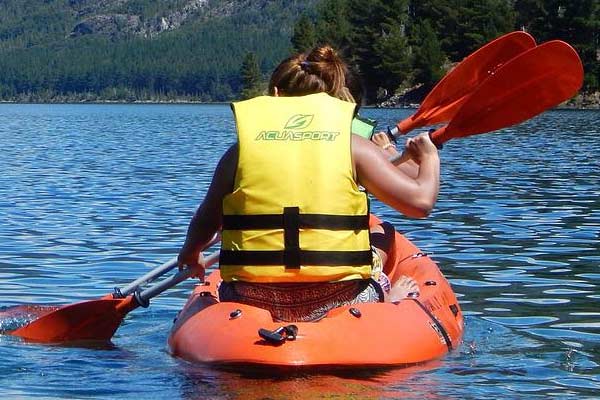Oil canning is a common issue that kayaks face, and it can cause many problems if it’s not fixed. Here, we will discuss oil canning, how to prevent it, and how to fix it if it occurs.
We’ll also provide tips on making your kayak more resistant to oil canning. So, whether you’re just starting in the kayaking world or you’ve been paddling for years, read on for all the information you need!
What is Kayak Oil Canning?
Oil canning is a condition that causes waves or ripples to form in the hull of a kayak. This can be caused by several factors, including the type of materials used in the kayak, how the kayak is constructed, and even the paddler’s weight.
While oil canning does not affect the kayak’s performance, it can be unsightly and may cause the paddler to feel uneasy.
Reasons for Kayak Oil Canning to Happen
• Poor storage. If you store your kayak on its side, the weight of the kayak will eventually cause it to deform outward in that area. As your kayak bakes in the sun, the heat will cause the plastic to become more malleable.
• Poor transportation. Your kayak may bounce around while traveling if you don’t have the proper racks or tie-downs, which could lead to deformation.
• Insufficient support. If you don’t have your kayak supported evenly on all sides, it can start to deform from the weight.
• Manufacturing defect. Sometimes a kayak is just made poorly and will start to deform over time no matter how well you take care of it.
How to Prevent Kayak Oil Canning
i. High-quality material. There are different types of kayaks in the market. Some are made of high-quality materials while others are not.
Make sure to choose one that is made of high-quality materials. This will help to prevent oil canning because high-quality materials are less likely to deform.
ii. Regular maintenance. You must regularly check your kayak for any wear and tear. If you see any, make sure to fix it immediately. This will help to prevent oil canning because it will keep your kayak in good condition.
iii. Avoid using your kayak in extreme conditions. Kayaks are made to be used in calm waters. Using your kayak in extreme conditions is more likely than an oil can.
iv. Store your kayak correctly. When you are not using your kayak, store it properly. This means you should not leave it in the sun or a hot place, as doing this will keep your kayak from being exposed to extreme temperatures.
v. Be careful when using your kayak. Be careful not to hit your kayak against rocks or other complex objects when using it.
vi. Inflate your kayak correctly. When inflating your kayak, do it properly, meaning you should not overinflate or underinflate it.
How to Fix Kayak Oil Canning
If your kayak has already begun to oil can, don’t despair! You can do a few things to try and fix the problem, including:
The Sunny Side Up Method
i. Lay the kayak on the saw horses upside down. This will give you better access to the inside of the hull.
ii. Ensure that the kayak’s hull is exposed to direct sunlight. It would be best if you considered the time of day and the season when you do this so that the sun is not too hot or too low in the sky.
iii. Let the kayak soak up the sun’s rays for at least two hours. The heat will cause the kayak to expand and hopefully fix the oil canning.
iv. Examine the hull. If the oil canning is not entirely gone, you may need to repeat this process or try another method.
The Hot Water Bath Method
i. Place the kayak on saw horses or stand it vertically.
ii. Fill a bathtub or large container with hot water, ensuring the entire kayak fits inside.
iii. Submerge the kayak in hot water, ensuring the entire hull is covered.
iv. Leave the kayak in hot water for 30 minutes to allow the hull to soften.
v. Remove the kayak from the hot water and allow it to cool for a few minutes.
vi. Repeat steps two through five until the kayak is permanently warped.
The Heat Acceleration Method
i. You will need to find a spot to lay your kayak horizontally. You will also need access to both ends of the kayak. If you are working on the kayak’s hull, ensure it is completely dry before starting this process.
ii. You will need to heat one end of the kayak using a heat gun. You will want to hold the heat gun about six inches from the kayak and move it around in a circular motion. Be careful not to overheat the kayak as this could cause damage.
iii. Once the kayak is heated, you will need to quickly cool down one end of it using a cold compress. You can do this by placing the compress on the kayak and then moving it around in a circular motion.
iv. Repeat steps two and three on the other end of the kayak.
v. Once you have heated and cooled both ends of the kayak, you will need to place it in a cool environment for about an hour. This will allow the kayak to cool down completely and help fix the oil canning.
Following these steps will ensure your kayak will no longer have oil canning. If you are still having problems with oil canning, you may need to repeat this process or try another method.
Tips on Making Your Kayak More Resistant To Oil Canning
i. Using a thicker hull. The wider the hull, the more resistant it is to oil canning.
ii. Add reinforcement ribs. Reinforcement ribs help to add stiffness to the hull.
iii. Make the kayak asymmetrical. Asymmetrical kayaks are less likely to oil can than symmetrical kayaks.
iv. Increase the rocker. Rocker is the amount of curve in the bottom of the kayak. The more rocker, the more resistant the kayak is to oil canning.
Conclusion
So there you have it! Oil canning in kayaks is a common issue that various factors can cause. However, a few simple solutions can help prevent or fix the problem.
Following the tips above, you can help keep your kayak in good condition and avoid unnecessary damage. Happy riding!




